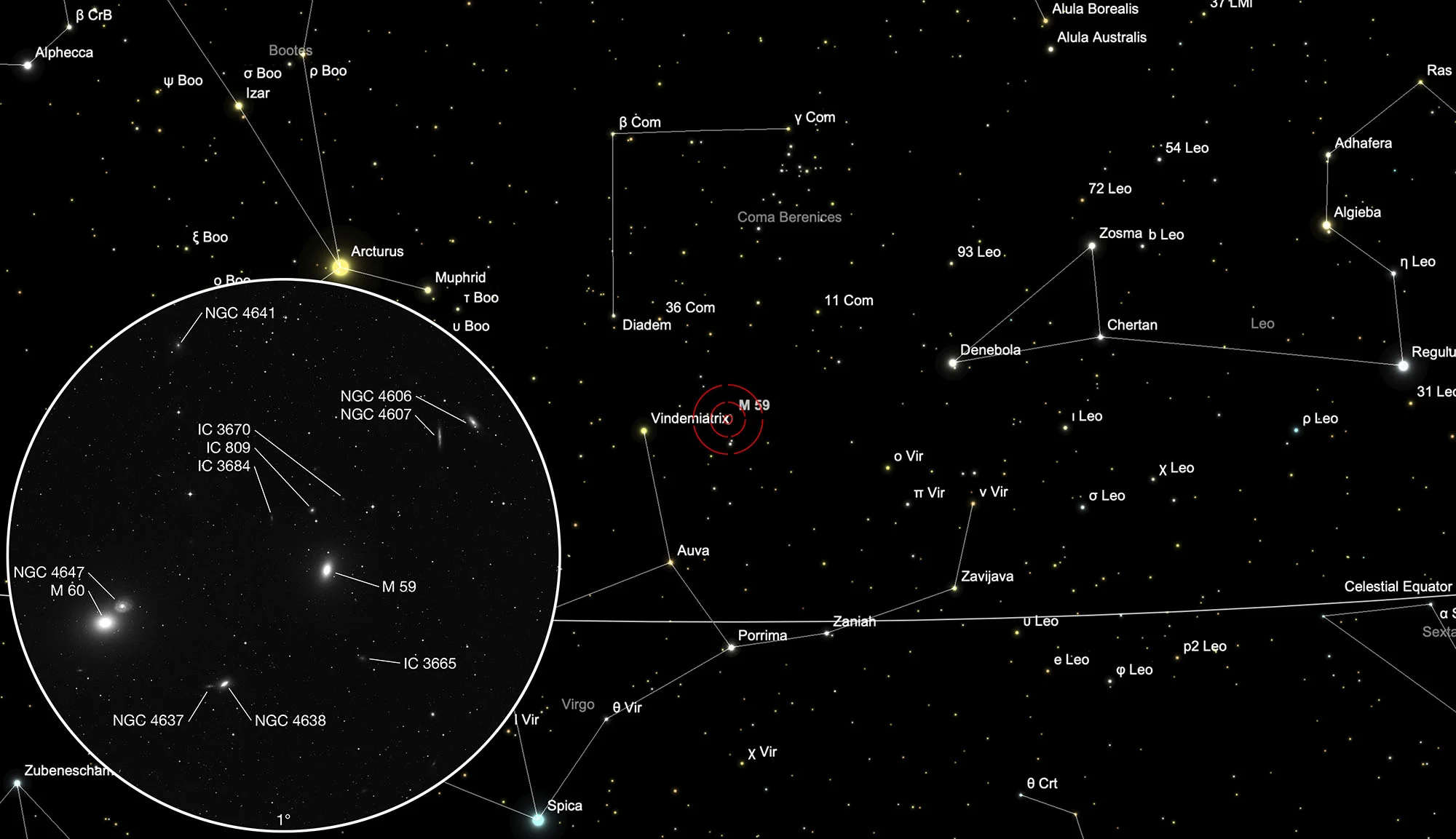Galaxies Messier 59 & Messier 60
Messier 59
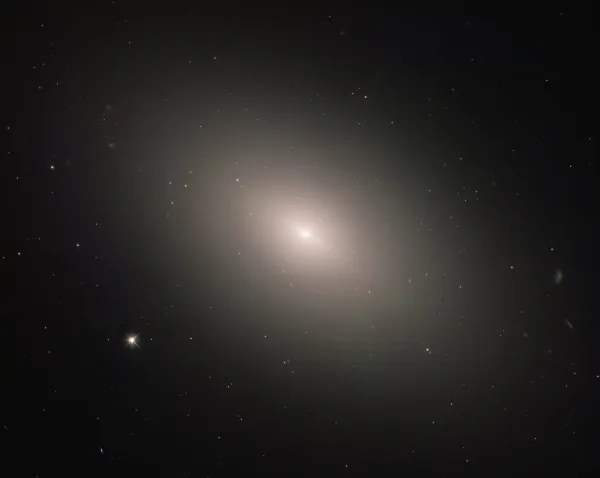
The discovery of this galaxy is attributed to the German astronomer Johann Gottfried Koehler on 11 April 1779. Charles Messier came across the same galaxy just a few days later and included it as number 59 in his catalog of nebulous celestial objects. Both encountered this galaxy while observing the comet in 1779. Messier mentioned the nebula on his 1779 map of the comet. [217]
M 59 is an elliptical galaxy. Although elliptical galaxies, along with spiral galaxies and irregular galaxies, are considered to be the most developed form, M 59 shows signs of star formation in a disk near the centre. In this there is a black hole with about 270 million solar masses. The innermost 200 light years of the galaxy rotates in the opposite direction. M 59 is surrounded by around 2200 globular clusters. The galaxy is located about 50 million light years away in the Virgo Galaxy Cluster. [215, 245]
| Designation | NGC 4621 |
| Type | Gx (E5) |
| Right Ascension (J2000.0) | 12h 42m 02.2s |
| Declination (J2000.0) | +11° 38' 50" |
| Diameter | 5.4 × 3.7 arcmin |
| Photographic (blue) magnitude | 10.6 mag |
| Visual magnitude | 9.6 mag |
| Surface brightness | 12.9 mag·arcmin-2 |
| Position Angle | 165° |
| Redshift (z) | 0.001368 |
| Distance derived from z | 5.78 Mpc |
| Metric Distance | 15.550 Mpc |
| Dreyer Description | B, pL, lE, vsvmbM, 2 st p |
| Identification, Remarks | h 1386; GC 3155; M 59; UGC 7858; MCG 2-32-183; CGCG 70-223; VCC 1903 |
Messier 60 + NGC 4647 (Arp 116)
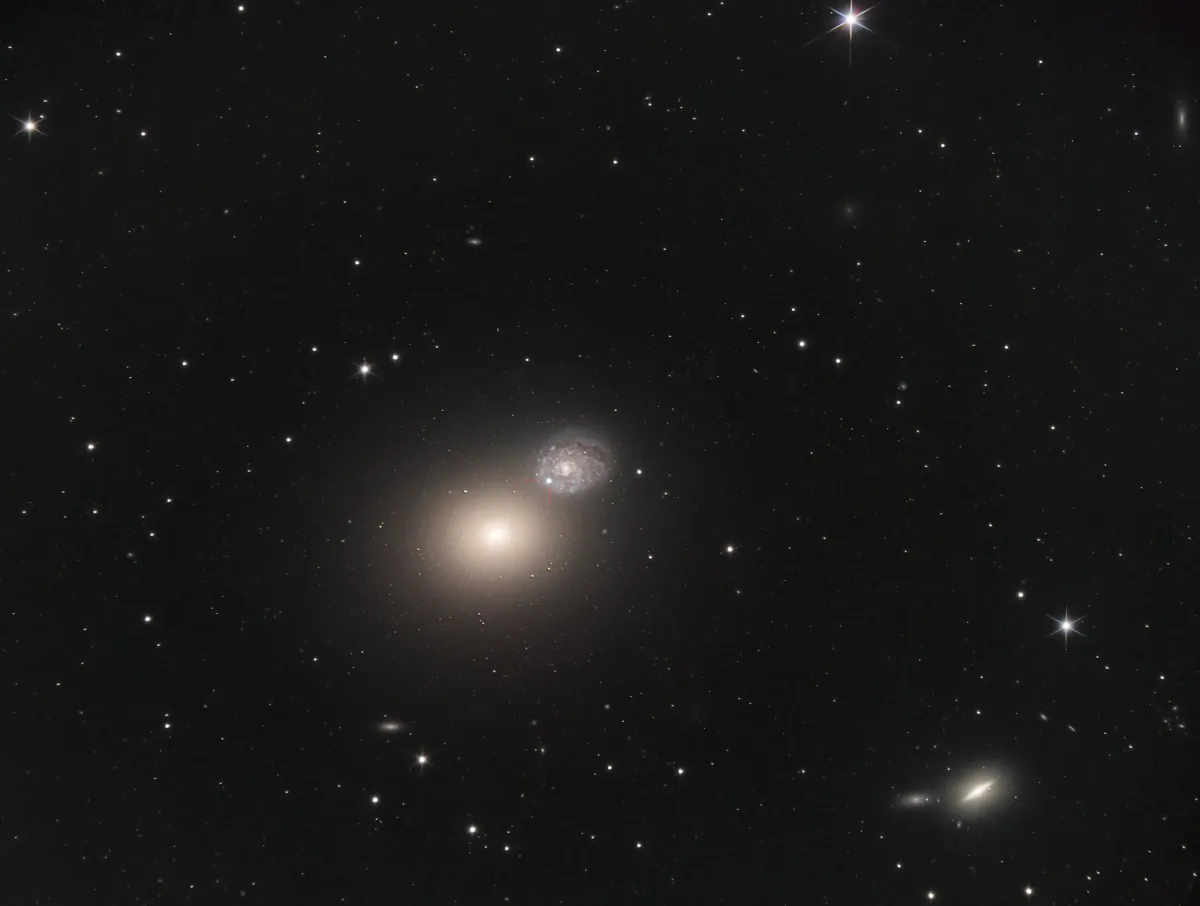
The galaxy M 60 was discovered together with M 59 on 11 April 1779 by the German astronomer Johan Gottfried Koehler and four nights later by Charles Messier. On April 13 and 14, the comet of 1779 passed so close to the galaxies that it appeared in his telescope in the same field of view as the galaxies and outshone them, which is why Messier did not discover the galaxies until the following night. [217]
M 60 is located in the Virgo galaxy cluster, which contains more than 1300 galaxies. At 9.8 mag, it is the third brightest galaxy in the Virgo galaxy cluster, measures around 120'000 light years in diameter and is around 54 million light years away.
In contrast to spiral galaxies, elliptical galaxies do not have organized structures and visible features. They are more like the core of a spiral galaxy. The mass of M 60 is estimated to be around one trillion (1012) solar masses, 4.5 billion (4.5·109) of which are due to the supermassive black hole in the centre of the galaxy. [215]
The spiral galaxy NGC 4647 is only about two thirds the diameter of M 60 and also less mass. It is similar to the order of magnitude of our Milky Way. Their distance to earth is about 63 million light years, that to M 60 about 9 million light years. [244]
Astronomers have long tried to determine if the two galaxies were interacting with each other. Halton Arp had included the pair of galaxies as No. 166 in his 1966 «Atlas of Peculiar Galaxies». [199] Although they appear to overlap from Earth, there is no evidence of star-forming regions, which is one of the clearest signs of interaction. However, studies made from the very detailed Hubble photos suggest the onset of tidal interaction between the two. [215]
| Name | RA | Dec | Type | bMag | vMag | B-V | SB | Dim | PA | z | D(z) | MD | Dreyer Description | Identification, Remarks |
|---|---|---|---|---|---|---|---|---|---|---|---|---|---|---|
| NGC 4647 | 12 43 32.5 | +11 34 58 | Gx (SBc) | 11.9 | 11.3 | 0.6 | 13.2 | 2.9 × 2.3 | 125 | 0.004700 | 19.85 | 18.300 | pF, pL, lE 115° ±, np of D neb | WH III 44; h 1405; GC 3180; UGC 7896; MCG 2-33-1; CGCG 71-15; IRAS 12410+1151; VCC 1972; VV 206; Arp 116; KCPG 353A |
| NGC 4649 | 12 43 39.8 | +11 33 11 | Gx (E2) | 9.8 | 8.8 | 1.0 | 13.0 | 7.6 × 6.2 | 105 | 0.003726 | 15.74 | 16.270 | vB, pL, R, f of D neb | h 1408; GC 3182; M 60; UGC 7898; MCG 2-33-2; CGCG 71-16; VV 206; Arp 116; VCC 1978; KCPG 353B |
Galaxies NGC 4606 and NGC 4607
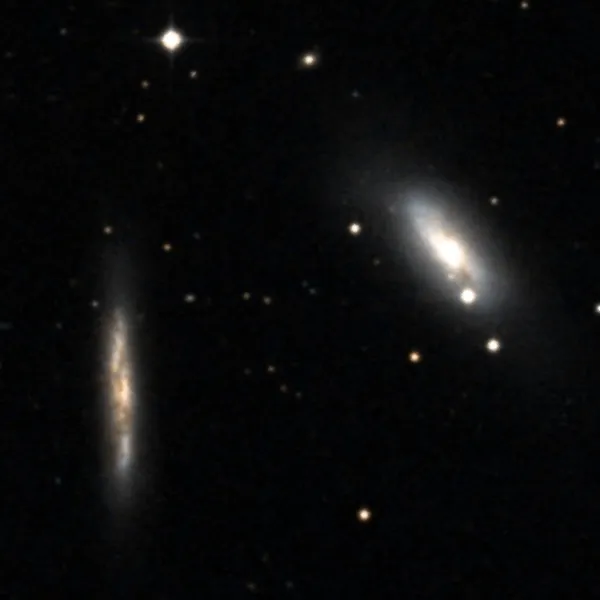
NGC 4606 was discovered by William Herschel on 15 March 1784. The adjacent galaxy NGC 4607 was missed by both he and his son. It was discovered by RJ Mitchell, an assistant to Lord Rosse, on 24 April 1854. Distance data according to Simbad to NGC 4606: 12.5 to 20.1 Mpc (40.8 to 65.6 million light years) and to NGC 4607: 8.4 to 19.9 Mpc (24.7 to 64.9 Million light years). Although the two galaxies are close together, they do not appear to be gravitationally bound to each other due to the difference in redshift of 600 km/s. [145, 196]
| Name | RA | Dec | Type | bMag | vMag | B-V | SB | Dim | PA | z | D(z) | MD | Dreyer Description | Identification, Remarks |
|---|---|---|---|---|---|---|---|---|---|---|---|---|---|---|
| NGC 4606 | 12 40 57.5 | +11 54 43 | Gx (SBa) | 12.7 | 11.8 | 0.9 | 13.5 | 3.3 × 1.7 | 33 | 0.005470 | 23.10 | 20.000 | vF, pS, E, 2 or 3 vS st inv | WH III 43; h 1382; GC 3143; UGC 7839; MCG 2-32-174; CGCG 70-213; VCC 1859; IRAS 12384+1211 |
| NGC 4607 | 12 41 12.2 | +11 53 08 | Gx (SBb) | 13.8 | 12.8 | 1.0 | 13.4 | 2.9 × 0.7 | 2 | 0.007572 | 31.98 | 20.000 | F, mE, 3' or 4' f III 43 | UGC 7843; MCG 2-32-176; CGCG 70-216; VCC 1868; IRAS 12386+1209 |
Galaxies NGC 4637 and NGC 4638
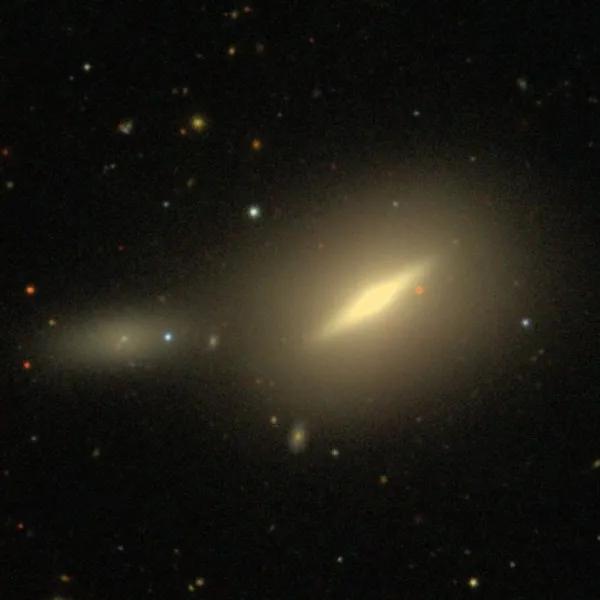
The galaxy NGC 4638 is the brighter of the two with 12.1 mag and was discovered by William Herschel on 15 March 1784. The immediately adjacent galaxy NGC 4637 with 14.8 mag was only discovered on 1 March 1854 by R. J. Mitchell, an assistant to Lord Rosse. Later there was a confusion in the identification of the two galaxies, which is why NGC 4638 has the smaller right ascension than NGC 4637, although in J. L. E. Dreyer's «New General Catalogue» its objects were sorted according to ascending right ascension. [196]
| Name | RA | Dec | Type | bMag | vMag | B-V | SB | Dim | PA | z | D(z) | MD | Dreyer Description | Identification, Remarks |
|---|---|---|---|---|---|---|---|---|---|---|---|---|---|---|
| NGC 4637 | 12 42 54.2 | +11 26 17 | Gx (S0) | 14.9 | 13.9 | 1.0 | 13.4 | 1.2 × 0.5 | 98 | Makes a D neb with h 1402 (?) | GC 3172; UGC 7881; MCG 2-32-188; CGCG 71-7; VCC 1945 | |||
| NGC 4638 | 12 42 47.3 | +11 26 33 | Gx (E-S0) | 12.1 | 11.2 | 0.9 | 12.3 | 2.2 × 1.4 | 125 | 0.003883 | 16.40 | 17.060 | F, R, gbM | WH II 70, II 176; h 1402; GC 3171; NGC 4667; UGC 7880; MCG 2-32-187; CGCG 70-229; CGCG 71-6; VCC 1938 |
Galaxies NGC 4641, IC 809, 3665, 3670, 3684
Another five galaxies in the same field of view are listed here for the sake of completeness. They appear very small and inconspicuous. Images below are 3.8 x 2.9 arc minutes excerpts from the Sloan Digital Sky Survey. [147] Galaxie IC 809 was assigned a number IC 3672 in the second edition of Dreyer's «Index Catalog».
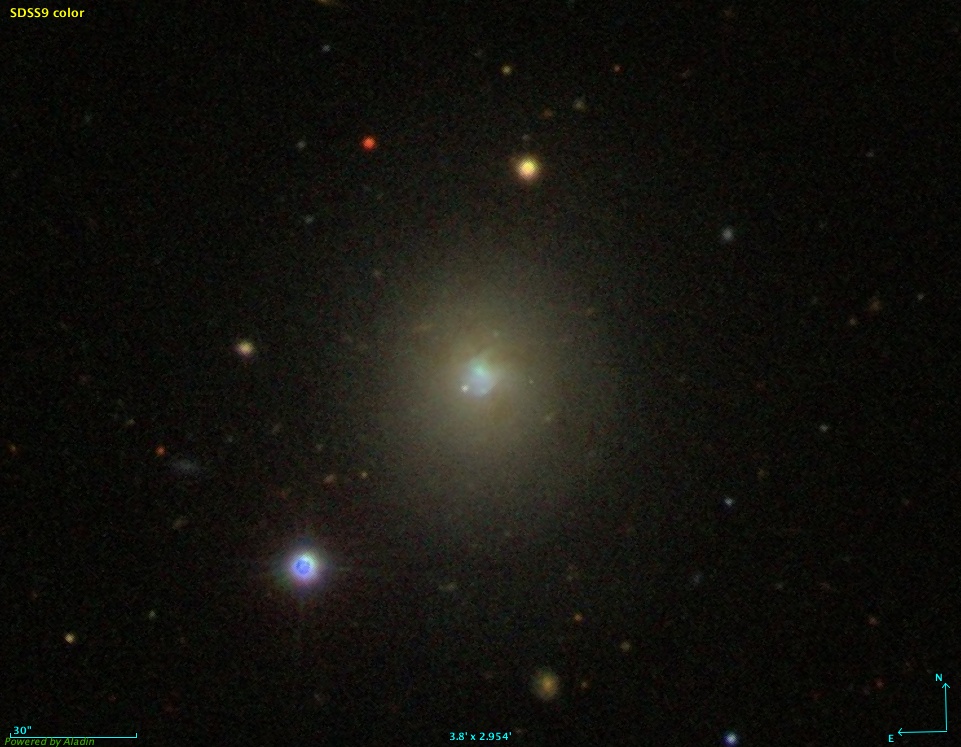
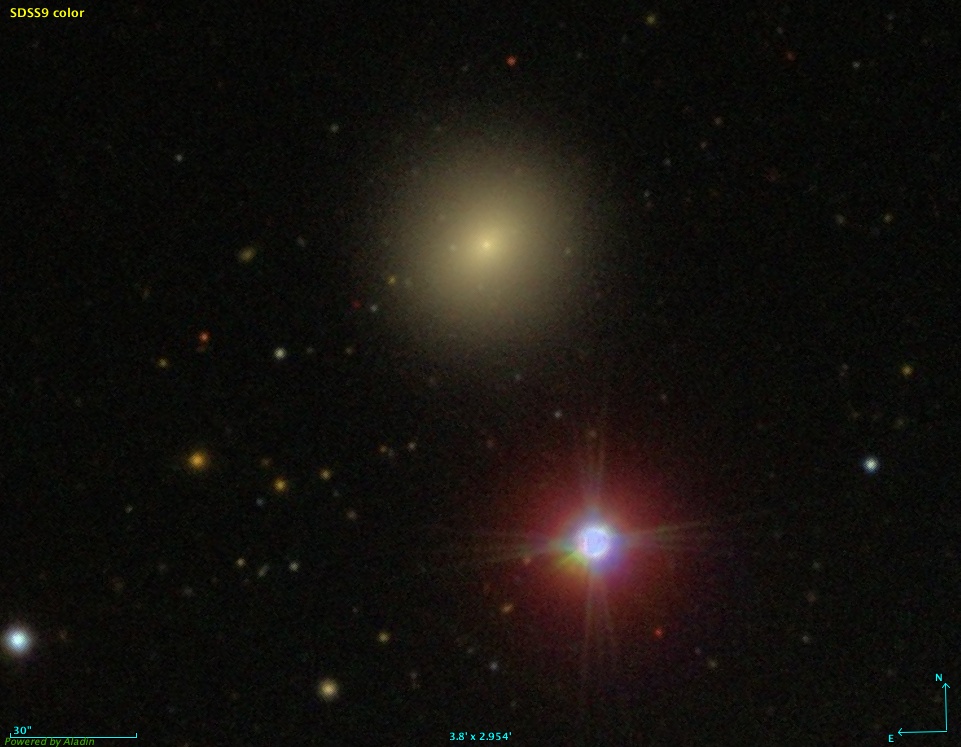


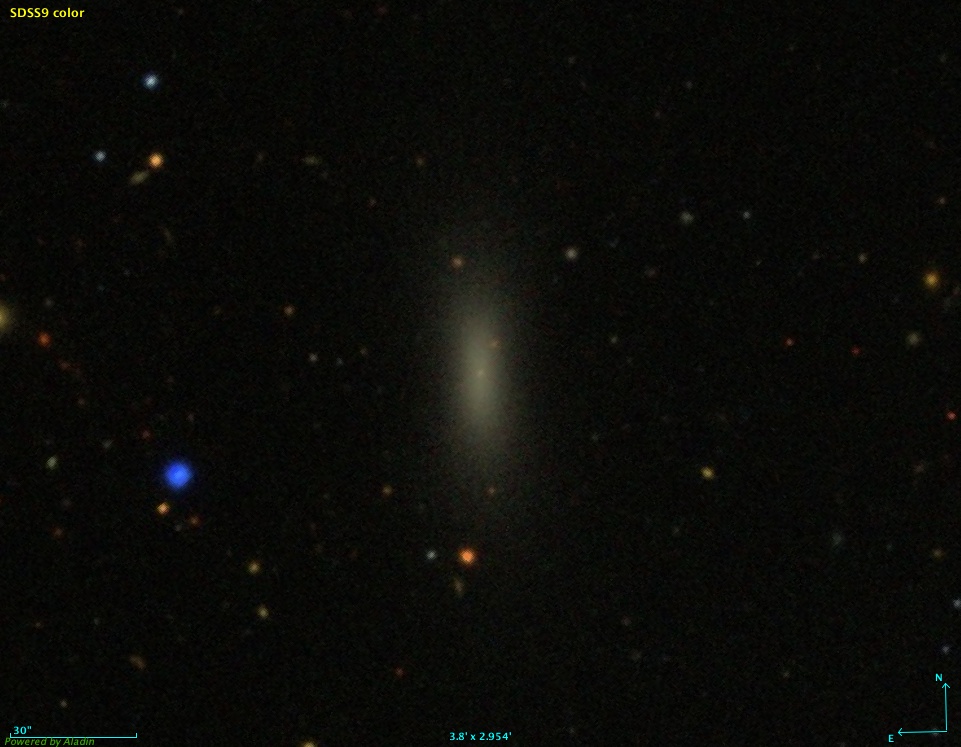
| Name | RA | Dec | Type | bMag | vMag | B-V | SB | Dim | PA | z | D(z) | MD | Dreyer Description | Identification, Remarks |
|---|---|---|---|---|---|---|---|---|---|---|---|---|---|---|
| NGC 4641 | 12 43 07.6 | +12 03 05 | Gx (S0) | 14.2 | 13.2 | 1.0 | 13.2 | 1.2 × 1 | 170 | 0.006708 | 28.33 | eF, pL, R, F * nr f | UGC 7889; MCG 2-32-191; CGCG 71-11; VCC 1955; NPM1G +12.0332 | |
| IC 809 | 12 42 08.7 | +11 45 15 | Gx (E0) | 14.2 | 13.2 | 1.0 | 13.3 | 1 × 1 | 0.000687 | 2.90 | 15.760 | eF, pS, R, M 59 s | IC 3672; UGC 7863; MCG 2-32-184; CGCG 70-225; VCC 1910 | |
| IC 3665 | 12 41 46.6 | +11 29 17 | Gx (Im) | 15.1 | 14.5 | 0.6 | 14.0 | 0.9 × 0.6 | 72 | 0.004093 | 17.29 | F, S, R, dif | UGC 7855; MCG 2-32-180; CGCG 70-220; VCC 1890 | |
| IC 3670 | 12 41 55.0 | +11 46 24 | Gx (E2) | 16.0 | 15.0 | 1.0 | 13.3 | 0.5 × 0.4 | 5 | 0.024400 | 103.0 | vS, R, bM | ||
| IC 3672 | 12 42 08.7 | +11 45 15 | dup | 14.2 | 13.2 | 1.0 | 13.3 | 1 × 1 | 0.000687 | 2.90 | 15.760 | vF, vS, R, stell, I.C. 809 n | IC 809; UGC 7863; MCG 2-32-184; CGCG 70-225; VCC 1910 | |
| IC 3684 | 12 42 26.5 | +11 44 22 | Gx (S0-a) | 16.0 | 15.1 | 0.9 | 14.1 | 1.1 × 0.4 | 14 | 0.003872 | 16.36 | vF, vS, R | VCC 1921 |
Finder Chart
The group of galaxies is located in the constellation Virgo, roughly on the line connecting the stars Vindemiatrix (ε Virginis) and Denebola (β Leonis), about 4° (outermost Telrad ring) from Vindemiatrix. The best time for observation are the months of December to September. Then the constellation is highest at night.
Visual Observation
400 mm Aperture: As expected, the galaxy M 60 appears as a structureless, oval spot with a bright centre. But also in NGC 4647, apart from the bright centre, no structure is visible. The supernova SN 2022HRS, which was discovered on 16 April 2022, appears as a bright little star next to the nucleus of the galaxy. — 400 mm f/4.5 Taurus Dobsonian, Glaubenberg, SQM 21.27, a bit windy, Sahara dust and hazy, 22. 5. 2022, Bernd Nies
